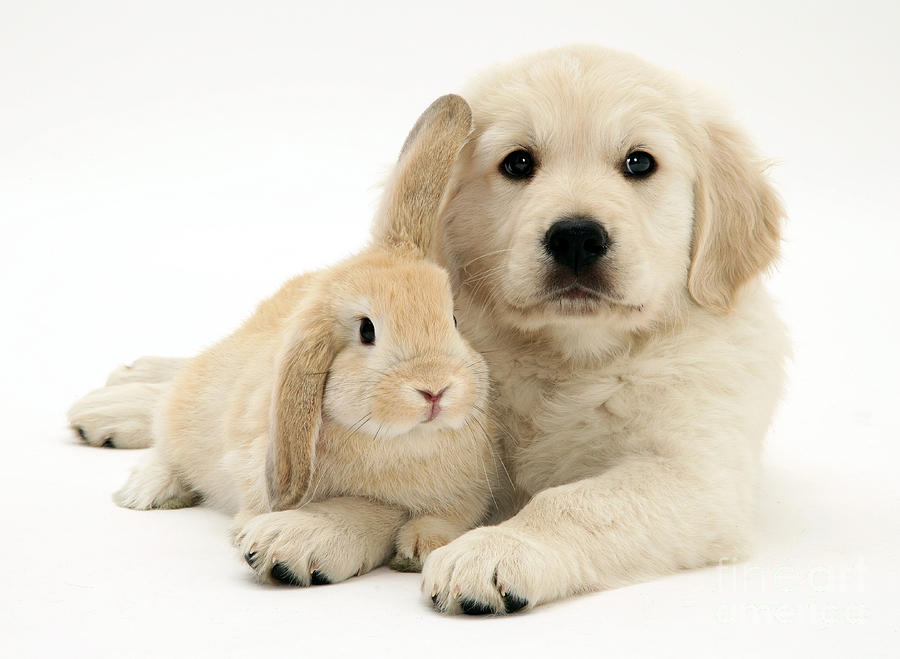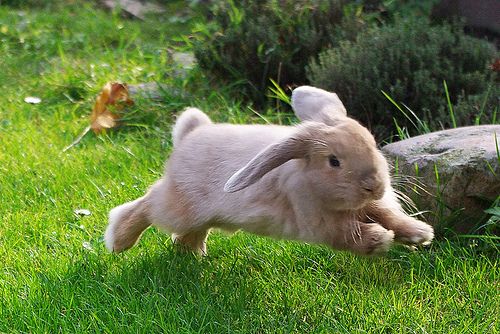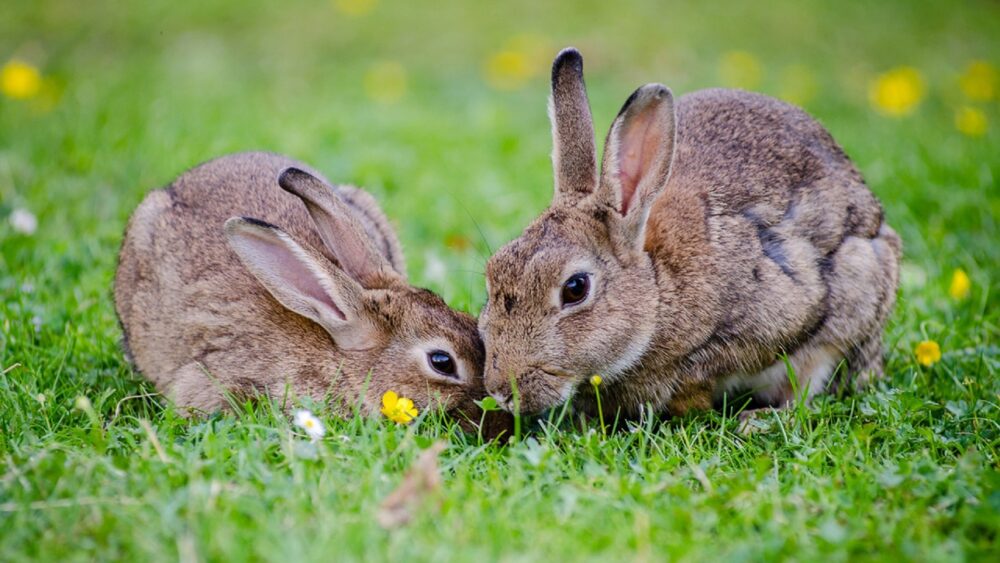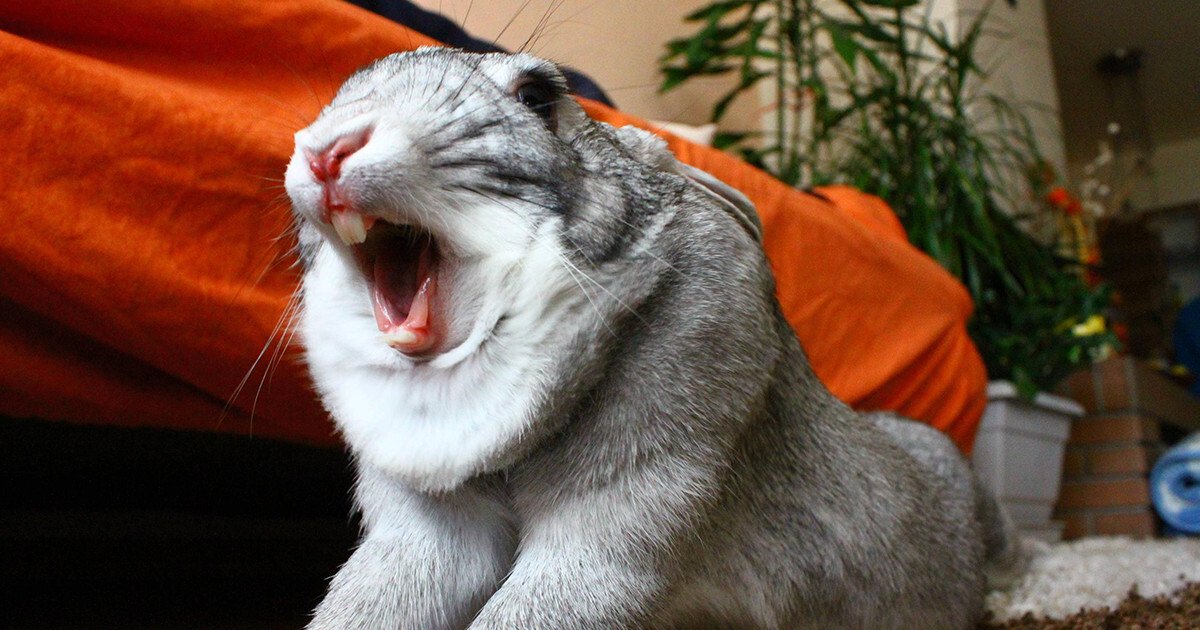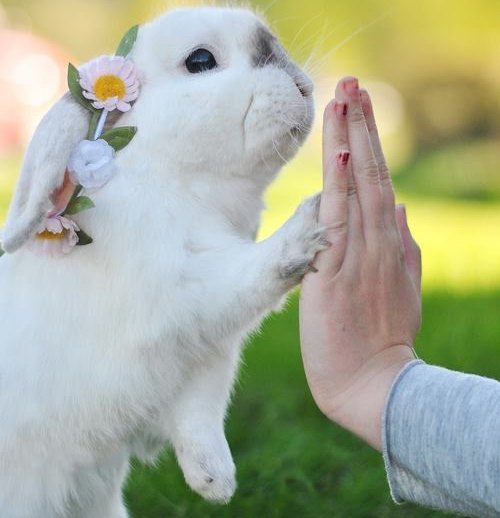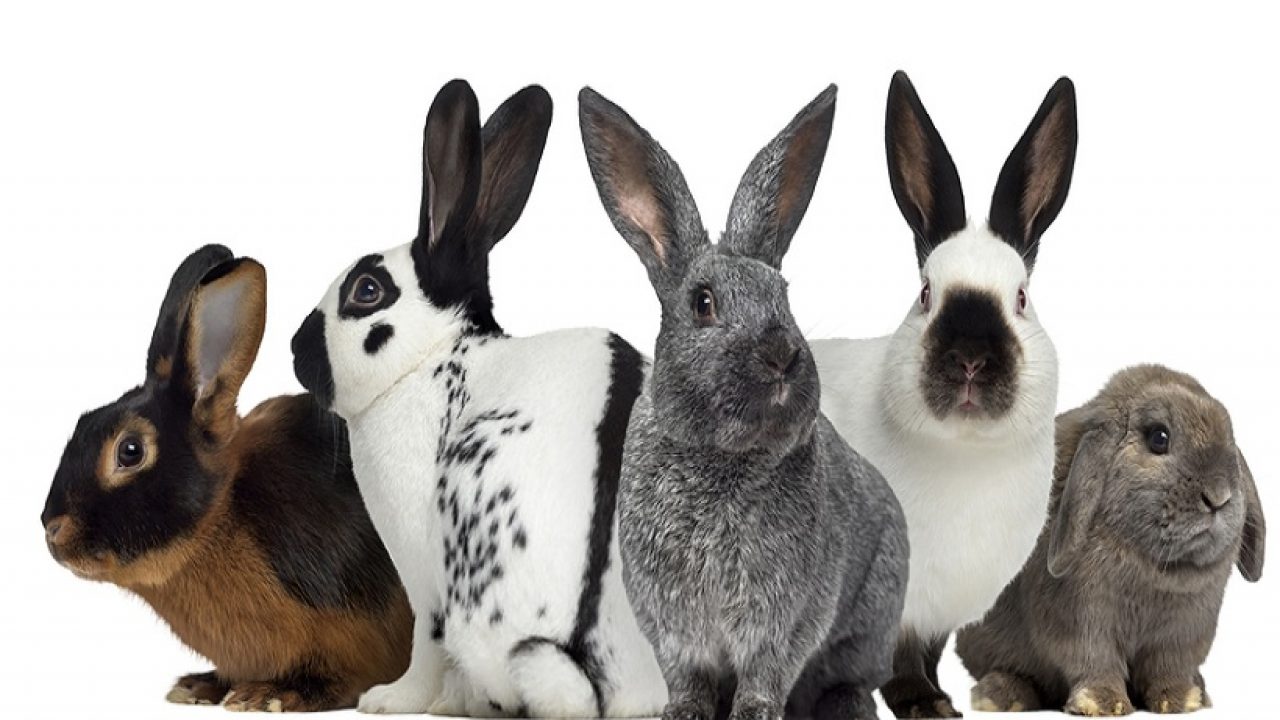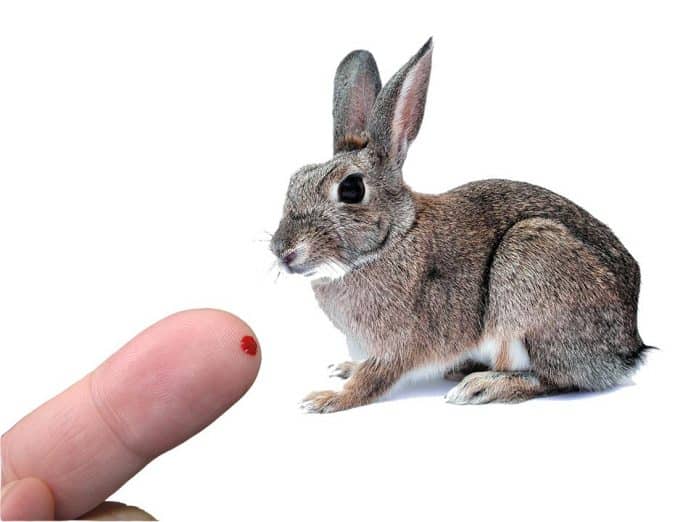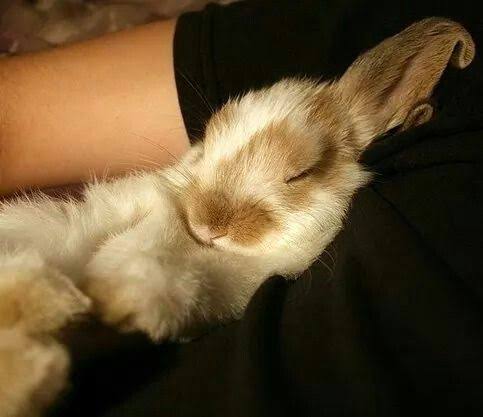Want To Learn How You Can Keep Dogs And Rabbits Together? Rabbits And Dogs Can Become Best Friends & Live Together With Proper Training. Learn More Inside
Continue reading7 Easy Steps To Teach Your Rabbit To Spin Around!
Have You Ever Wondered How To Teach Your Rabbit To Spin? Teaching Simple Tricks Can Be A Great Experience And Helps You Bond With Your Pet Rabbit!
Continue readingLearn How To Bond Two Rabbits In 5 Easy Steps
Rabbits Are Social Animals & Live Better With A Bonded Partner. Learn Step By Step How To Bond Two Rabbits Safely & Keep Them Living Happily Together.
Continue readingWhy Do Rabbits Scream & What Does It Mean?
Have You Ever Seen Rabbits Scream? Even Though Rabbits Are Non-Vocal Animals, They Can Scream Like Humans When They Are Scared, Distressed, Or Near Death.
Continue readingTeach A Rabbit To High Five In 6 Easy Steps
Wondering how to teach a rabbit to high five with you? Well, you are in the right place. Teaching some basic tricks to pet rabbits is quite easy if you have an easy to follow guide and know exactly what to expect on each step.
Once your rabbit learns how to high five it will be a really cool trick to show off to all your friends! So here is a step by step guide on how to teach a rabbit to high five.
- Motivate Your Rabbit With Food
- Get Your Rabbit To Stand Up
- Let Your Rabbit Place Their Paws On Your Hand
- Try To Only Support One Of Their Paws
- Add Verbal & Hand Cues While Practicing
- Repeat Everyday To Perfect It
Teaching a rabbit to high five is easy as that and as long as you follow these six easy steps, you and your bunny will be high five masters in no time. Now let’s learn each of these steps in some more detail.
Motivate Your Rabbit With Food
The first part of teaching a pet rabbit any trick is to make sure that they are motivated and interested in learning. A rabbit who is not interested will be really hard to teach anything so make sure that you have plenty of treats and lots of patience when you start training your rabbit.
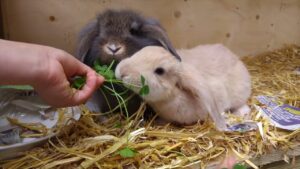
Treats for teaching a rabbit how to high five can just be regular rabbit pellets or bits of their favorite fruit. As long as you can hold the attention of your rabbit you should be good to go.
Start out by interacting and playing with them as well as giving them an occasional treat during play time. This can help to get them used to interacting and playing with you as well getting them hooked on the treats so that it can be used as rewards during training.
Get Your Rabbit To Stand Up
The next step in training a rabbit to high 5 is to getting them to stand up. Even though this step seems completely unrelated to giving them a high five, you have to remember, most rabbits have really short arms and may not be able to balance themselves during a high five if they are on all fours.
This is why getting them to stand up can really help making the rabbit more comfortable while learning how to high five.
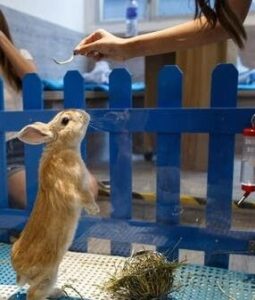
To make a rabbit stand on its feet, show them a treat and slowly raise it beyond their reach. If you do this slowly then you may see your rabbit standing up straight to get a hold of the treat you are offering.
Keep doing this for a couple of days to make sure that your rabbit is really comfortable while standing and happily taking treats out of your hands while standing up.
If you see that your rabbit is not standing or is losing their balance while standing then don’t worry. Some rabbits such as smaller breeds such as Dwarf rabbits or really large rabbits like Flemish giant rabbits can find it a bit difficult to stand up on their hind legs.
The next step will ensure that your rabbit can easily stand up and get into the movements of actually give a high five.
Let Your Rabbit Place Their Paws On Your Hand
By now you should easily be able to get your rabbit to stand up while you give them a treat. You may even find that your bunny is standing up on their own whenever they see you but if you are having some trouble in getting them to stand this out.
Let your rabbit rest its paws on your hand, even though this is not exactly a high five but its can help your bunny get started with doing the movements of the trick.
Every time you give them a treat extend out your hand like a high five and see if the rabbit places it’s paws on your hand. If not then try moving in a bit closer and enticing them with a treat to stand up.
A rabbit is most likely to place their paws on your hand when they are standing up as it helps them balance their body and is a much more secure position for them to be in.
Once your rabbits is really comfortable in placing their paws on your hand then you can move on to the next step.
Try To Only Support One Of Their Paws
This is perhaps the most difficult step in teaching a rabbit to high five. By now your bunny should be able to easily rest its paws on your hands. Now to get them to just extend one of their paws, this is what you need to do.
Extend your palm out so that your rabbit can rest their paws on it as usual but drop one of their paws. Only let them rest one of their paws on your hand and eventually, they will get used to it and only try reaching out with one hand instead of two.
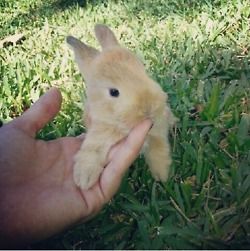
Although it sounds quite simple at first, trust me this part of the trick is going to take a few days but may even take a couple of weeks for your rabbit to get perfectly. After all, you are trying to teach them something that is completely different from their natural instinct.
There you have it, you have trained your pet rabbit to high five but it isn’t over yet. Move on to the next step and find out how you can improve on the trick.
Add Verbal & Hand Cues While Practicing
Till now we have been generous with the treats while training your rabbit to high five. But, that is not really healthy for them. Even though treats such as rabbit pellets or sweet as reward for giving a high five helps to re-enforce the trick in your rabbit’s mind.
Excess calories in a rabbit’s diet coming from treats can be a serious detriment to their health. Pet rabbits can easily get stomach problems like gas, stomach ache and even GI Stasis from overfeeding them treats. Bunny rabbits are also sustainable to getting obese if they keep getting excessive treats beyond what is allowed in a balanced diet.
The best way to cut down on the number of treats you need to give to your rabbit while teaching them to high five is with lots of verbal appreciation, petting and hand gestures that let them know that they are doing good.
Some people also go for clicker training but I find that plenty of verbal appreciation and petting can really help reduce the number of treats you need to give to a rabbit while teaching them how to high five if not completely replace them.
Repeat Everyday To Perfect It
The last and final step is to keep repeating every step that you have learned on how to teach a rabbit to high five every day or every other day.
Not only will this help you practice and perfect the trick with your rabbit, it will also help to condition your rabbit into learning new tricks that you may want to teach them in the future.
Remember the more time you spend each day playing, interacting and training your rabbit the more bonded your rabbit will become to you.
Faq On How To Teach A Rabbit To High Five
Here are some answers to the most asked questions on how to teach a rabbit to high five.
Can All Rabbits Learn To High Five?
Pretty much, any healthy rabbit should be able to learn tricks like giving a high five or coming to you when you call but that being said, some rabbits are naturally better at learning tricks than others.
For example, younger rabbits do better when you train them to high five than older rabbits. The breed of your rabbits may also come in consideraion, really bigh rabbits like Flemish Giant rabbits can have a harder time in learning skill that require complex movements simply due to their body weight.
But that being said, with plenty of treats and petting as motivation, most rabbits should be able to high five it you follow the steps in this post and have patience.
How Long Does It Take To Teach A Rabbit To High Five?
Normally it should take around a two to for weeks to teach a rabbit how to high five but it may take a big longer for some rabbits. It all depends on the rabbit’s age, breed and personality.
As long as you have enough patiente and follow the steps to teach a rabbit how to high five then even if it takes some time, your rabbit should eventually learn the trick.
Remember to also practice the trick from time to time otherwise your rabbit may forget some of the movements of the trick and you may have to being the training from the start.
My Rabbit Is Not Able To High Five Even After Training, What Should I Do?
All rabbits learn at a different pace, some rabbits are just faster at learning tricks like giving a high five.
Even though most rabbits should be able to learn simple tricks like giving a high five, some have a much easier time than others. There can multiple reasons for that including your rabbit’s age, breed, size etc.
But don’t be discouraged, be patient and keep at it. Follow the steps and eventually your rabbit should also be able to learn how to high five.
You can also consider teaching some other tricks first like spinning around or teaching your rabbit to come when you call. You may have an easier time teaching some other tricks first.
Whatever you do, never lose hope and best of luck.
Catagories
- New To Rabbits (16)
- Rabbit Behavior (9)
- Rabbit Care (18)
- Rabbit Diet (12)
- Rabbit Facts (10)
Top 10 Best Breed Of Rabbit For First Time Owners
If You Are Wondering What Is The Best Breed Of Rabbit For First Time Owners Then Find Out The Difference Between 10 Of The Most Popular Rabbit Breeds Worldwide.
Continue readingWhy Do Pet Rabbits Bite & How To Stop Rabbits From Biting?
Handling or interacting with rabbits the wrong way can easily scare or hurt them. In such cases, a pet rabbit may bite you. But there are multiple ways by which you can stop your rabbit from biting or nipping. Find out more inside.
Continue readingBiggest Pros & Cons Of Having A Pet Rabbit
Pet Rabbits Are Really Different From Other House Pets Like Cats Or Dogs. Here Are The Pros & Cons Of Having A Pet Rabbit And Who Should Get A Pet Rabbit!
Continue readingRabbit Behavior & Body Language Cheat Sheet For Beginners
If you are getting into raising rabbits or have pet rabbits for some time now then being able to learn and understand rabbit behavior is really important to you!
Rabbits are voiceless creatures and often rely on a mix of body language and behavior to communicate with their owners as well as other rabbits. Understanding your pet’s body language will not only help you understand how it is feeling and its mood but may also save your pet bunny’s life as you may be able to better understand if your rabbit is sick or in pain.
Here is a comprehensive guide to all types of rabbit behavior and what it all means!
1. Content Rabbit Behavior
These are the behaviors you might see in your rabbit when it is really content and satisfied with life and is going about its day worry free. Some common content rabbit behaviors are explained below.
Sniffing
Rabbits have very sensitive noses and weak eyes so they use their sense of smell as their primary source of exploring their environment. Rabbis usually sniff everything they come in contact with.
With their sense of smell they can easily differentiate between different people and other rabbits and this sense really helps them to identify their food or pheromones of other rabbits while mating.
Chewing
Rabbits are curious creatures, chewing is a way for rabbits to taste and explore their surroundings. It is very relaxing for your rabbit when it is chewing on something it likes.
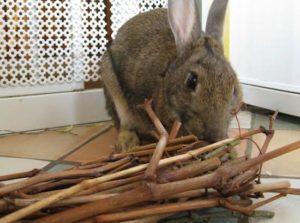
Rabbits like to chew on all sorts of things so it is very important that you provide it with plenty of things to chew like hay or twig toys so that it does not focus its chewing on your cloths or furniture.
Digging
Digging is a very natural behavior for pet rabbits as in the wild rabbits tend to make burrows in the ground to live and raise their young.

More often then not, digging can be seen as a playful behavior. Rabbits feel right at home while digging and it relaxes them and help them to relieve stress. So its best to keep them occupied with some cardboard boxes or old rugs which they safely dig on.
Eating
A rabbit eating happily is one of the most adorable things in the world. Rabbits love to eat get a mood boost when given food by its owners.
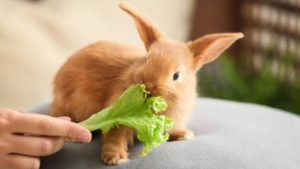
Your rabbit eating and drinking is one of the most important behaviors you must keep an eye out for. Rabbits are fragile creatures and the biggest reason for rabbit deaths in the US is a gut blockage. While it is treatable, a quick intervention often gives the highest chance of recovery.
So if your rabbit is not eating or drinking, it may be a sign that something is wrong with its health. Learn a bit more about the best foods to give to your rabbit you can check out our article on What Can Rabbits Eat? The Best Pet Rabbit Diet!
Laying Down
Loafing
Loafing is a resting position for rabbits where they tuck in their arms and legs under their body. Since they look like a loaf of bread in this position, it has been named loafing by the rabbit community.

Loafing is also a sign of a content rabbit that feels comfortable resting around you. Some rabbits also like to sleep in this position while some do not.
So if you see that your rabbit does not sleep at all but is always sitting in the loaf position then worry not, rabbit can sleep very well while loafing.
Stretching
Rabbits love to stretch their body after laying down or sleeping for a while. They usually stretch their body by placing their forearms in front of their body and stretch their whole body out.

They may do this multiple times and this may be accompanied with a bit of yawning and shaking their body.
Shaking
Again this is something very normal for rabbits. They will shake their whole body from head to their butts. This is something rabbits will do after grooming or after laying down for a while.
This is done to shake off any dirt or parasites that may have crept on their fur while they were resting. This also helps to fluff up their fur which helps them to deal with the cold.
Plus it looks really adorable!
Yawning
This one is pretty self explanatory, rabbits like to yawn just like any other animals or us humans. This can usually be seen just after they have woken up from sleeping or while they are stretching.
Sleeping
This a rabbit’s favorite pass time. Rabbits like to sleep in batches, they usually do not sleep throughout the day. Since rabbits are prey animals, they are quite weary about their sleep and tend to only sleep soundly where they feel really safe.
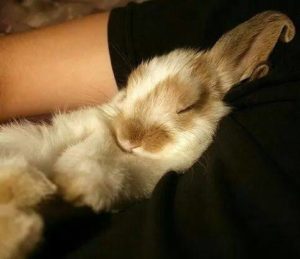
Rabbits also have the ability to sleep with eyes open so just because your rabbit has their eyes open while resting does not mean they are not sleeping.
Rabbits prefer a quite environment while sleeping to feel safe. Remember their ears are hundreds of time more sensitive than ours, therefore keeping your rabbit in a very noisy environment may effect their health due to lack of peaceful sleep.
Grooming
Rabbits are neat freaks, they like to groom and clean themselves all the time. You would be surprised to learn that rabbits groom themselves much more than cats do.
This extensive grooming routine has made rabbits into one of the cleanest house pets. Rabbits don’t have any body odor either, all due to their impeccable grooming habits.

Grooming is also a sign of a happy, healthy and content rabbit, so enjoy watching your rabbit groom itself as they look adorable doing it.
Nudging
You may have seen your bunny nudge things with its face sometimes, this nudging is a way for rabbits to explore and feel their environment. Rabbits may also nudge something or someone if they are in its way.
So nudging is not at all an aggressive behavior at all, its just a way for them interact with their environment.
Nipping
Nipping is also a way for rabbits to communicate with each other and their owners, typically it is much softer than a bite and feels like a pinch.
Again this nipping behavior is also a way for rabbits to interact with their environment, some rabbits do nip more than others. Rabbits tend to nip when they are bonding with other rabbits or when they are trying to get the attention of their owners.
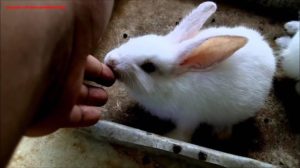
In case a rabbit is nipping to hard and it is hurting you then you may want to check out our article on How To Prevent Your Rabbit From Nipping & Biting
Panting
Rabbits sometimes tend to pant when they get tired from a lot of physical exercise. This is completely normal and nothing to scared of, they are just trying to catch a breath and rest a bit.
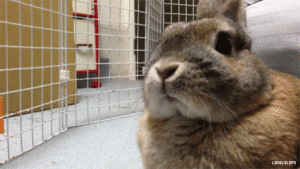
This is also a way for rabbits to regulate their body heat as they cannot sweat to cool down.
Pinned Ears
Although pinned ears is often a sign of aggression for rabbits, it may not be the case every time. Some rabbits just like to pin their ears in and rest or sleep.
It is also something that you may never observe with rabbit with large ears like lops, so just don’t worry about it.
Raised Tail
Again, the raised tail is seen as a sign of aggression under most circumstances but it is also something that all rabbits do just before going to the bathroom.
Some rabbits may just sit around with a raised tail, so this one is very situational.
Running
Running is something that all rabbits love to do, most often rabbits will run around in a playful manner. This is also excellent exercise for you bunny so provide them with plenty of space to hop and run around.
Scratching & Itching
Again this is a very normal behavior for your bunny. Rabbits will scratch all over if they have an itch or while grooming.
They usually scratch with their hind legs and then lick their toes to check what they have scratched out. This helps them identify if they have scratched out a parasite, this is one of the traits that help rabbits stay so clean and tidy.
2. Happy Rabbit Behavior
These are the behaviors you will see in your rabbits when they are really happy and excited. These behaviors indicate that your rabbit is having a wonderful life and bonding with you really well.
Begging
All bunnies love treats, especially when you hand feed it to them. That is why you will often see your rabbit stand up on its hind legs and beg for treats from you.

Rabbits only do this when they are excited and happy. When your rabbit is begging it is best to give them a treat or two but remember that too many treats may make your rabbit obese and that can be life threatening for bunnies. So treats must be in moderation.
Binkying
This is one of the best things that rabbits do when they are really happy, they bounce in the air shaking their body from head to tail. This behavior is called a binky.
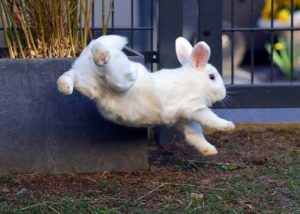
Some rabbits like to binky more than others and the binkys could be accompanied with fast running and hopping around! So if you want your bunny to binky around then make sure it has enough open space to do it safely.
Circling
Rabbits often like to circle around their owners or other rabbits, this if often considered a hormone driven sexual behavior but if your bunny is spayed and neutered then it more likely it is because your bunny is really happy to see you and wants your attention especially if it is expecting food from you.
You may also see them circling other rabbits as well, this means that your bunny is in a happy and playful mood.
Cuddling
This is pretty much self explanatory, if your rabbit is cuddling with you or its bunny friends then it means that it is very happy and feeling comfortable living with you. Pet rabbits are very affectionate so if they cuddle with you it means that you have their trust and your bunny considers you a true friend.
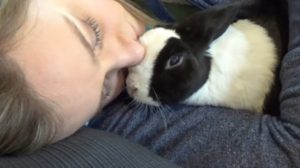
Be aware that rabbits do not stay still for long so if the suddenly jump up and leave while cuddling that does not mean that your bunny does not like cuddling with you.
To get your rabbit to cuddle with you more, try laying down on the floor and let your bunny come to you first instead of picking them up. This method will help raise your bunny’s confidence and help you bond better in the long run.
Bunny Flop
This is one of the most adorable things that bunnies do, one second they can be running at 500 miles per hour and the next second they tumble over. This is called the bunny flop. Rabbits are really happy and content if they are flopping around as rabbits are prey animals and they need to feel very comfortable in your house and with you to flop over.
Sometimes bunny flops can be a bit scary as the first time I saw one of bunnies flop I was sure that she was dead but rest assured, this is just a way for them to rest or express their happiness.
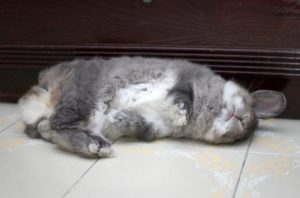
Also, be aware that some bunnies flop more than others and some don’t flop at all. Just because your rabbit does not flop as much does not mean that they are not happy. They may express their happiness in other ways.
Honking
Honking is a kind of sexual behavior that is often displayed by male rabbits during mating time but rabbits can honk at other times as well.
Some bunnies will honk while you pet them, its like a sign of appreciation.
Tossing & Carrying Things
Rabbits love tossing things around, they love to toss things as a sign of play like tossing their toys or their bowls. They may also sometimes toss stuff to move them out of their way.
Bunnies will also carry things in their mouths and run around, they do this take a toy or treat away from you or another bunny.
Rabbits will also toss stuff when they are angry or agitated but this is very rare.
Submitting To Be Pet
Asking to be pet is a sign of great happiness and a strong bond for rabbits. Rabbits do this by lowering their heads to their ground. They also do this when they want to be groomed by another rabbit.
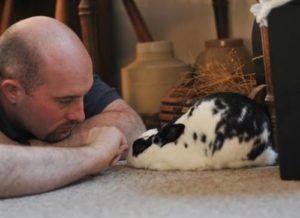
If a rabbit submits to be pet then go ahead and pet it but my advice would be not to pick up the rabbit while petting. Rabbits are prey animals, they get spooked easily and generally dislike being picked up as they feel they are being snatched away by predator so they might come to hate it.
After a while this leads the rabbit not submitting to be pet anymore. So gently does it.
Tooth Purring
This behavior is unique to rabbits where they will lightly grind their teeth when relaxing or being pet by you. This behavior is similar to that of cat purring but does not sound alike at all.
The sound that rabbits makes while tooth purring is like chewing and they will often move their jaws from side to side as well while lightly grinding their back teeth.
Rabbits only tooth purr when they are extremely satisfied and happy. So if your bunny is tooth purring then its a sign that your rabbit loves you.
Licking
Rabbits lick humans and other rabbits as a sign of affection, you’ll know what a lick is so not much to explain here.
Rabbits don’t spread any diseases to humans either therefore its perfectly fine if the lick you, bunnies are really clean and don’t smell either.
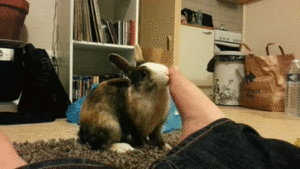
But I have had some rabbits that have never licked anyone so its not something that all rabbits will do. The best way to get your rabbit to lick you is to put your hand in front of their mouth while petting then and they will most likely lick your hand.
If not, keep trying. It feels great!
3. Fearful Rabbit Behavior
Up next are the behaviors you will see in rabbits when they are fearful or unhappy. As rabbits are prey animals, the get spooked quite easily so its recommended to keep your rabbit away from things that scare them.
Alert
When rabbits hear, see or smell something unknown or interesting they will often get into alert mode perking up their ears straight above their head and completely wide-eyed.
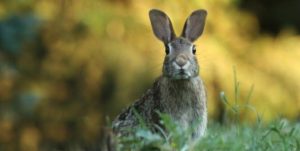
As rabbits are prey animals, when something spooks them rabbits try to carefully watch and listen for any threats.
Curious
Rabbits have quite poor eyesight, their eyes are to the side of their head so they have a blind spot just in front of them. That’s why rabbits bob their heads to get a better look at something they find interesting or while exploring a new area.
Sometimes when rabbits encounter an unfamiliar object or area you will often find them creeping by extending their head forward and bobbing their head down and up. This is a completely normal behavior and it means that you have an active and curious rabbit.
Rabbits sometimes also tilt their head and try to see with one eye, this helps them focus onto the object they want to see and helps their vision.
Panting
Panting heavily can be a sign of fear. When rabbits are in scary situations like when someone picks them up or if they are in a car, they can pant and hyperventilate.
Screaming
Although rabbits are not very vocal animals, they can actually scream loudly when they are in extreme pain or scared to death. This is very rare but can be seen sometimes in younger rabbits if you try to pick them up.
Hearing a rabbit scream is very disheartening as they only scream when they feel like they are going to die.
Going Limp
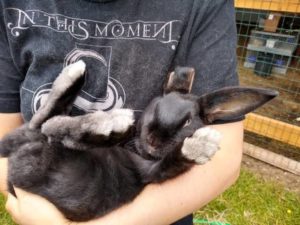
Once again, when are rabbits are very scared they get into this submissive position when you can do whatever you want with it but it won’t run away. This is like submitting yourself to fate kind of behavior. If your rabbit goes into this kind of a scared state due to some reason then its best no to meddle with them for some time and giving them a treat also helps to calm them down.
Thumping
When scared or annoyed rabbits will often stomp the ground with their hind legs. This makes a thumping noise, this behavior is most likely to alert other rabbits of anything scary that they have seen on heard.
Some rabbits will also thump when they are irritated or angry with their owners or other pets.
4. Aggressive Rabbit Behavior
Rabbits are highly social animals and as such can display a host of aggressive behaviors to convey their anger or irritation to other rabbits and their owners. The best way to coexist with your pet bunny will be to understand these behaviors and take up appropriate action.
Biting
Rabbits will sometimes bite their owners or other rabbits when they are really angry or if the others are doing something that the rabbits absolutely hates. A rabbit can bite someone for anything from picking them up, giving them medicine, grooming or clipping their nails.
Some bunnies may bite other rabbits as well especially if you are housing rabbits together which are not bonded or if the rabbits are displaying sexual aggressiveness.
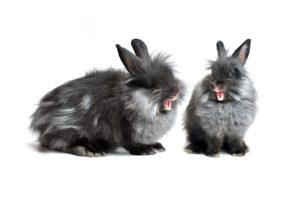
Biting behavior can be different from rabbit to rabbit depending upon their personality. Some rabbits bite a lot and some don’t bite at all. They may be a difference in the force of the bite as well, some bits may be painless while some can cut the skin.
If you have a rabbit that bites a lot then you need to train it so that it understands that biting is bad behavior. You can learn more about stopping your rabbit from biting here.
Boxing
Boxing is something that rabbits do when they are angry and want to fight, they lunge with their front feet onto another bunny or at their owner’s hand. This behavior is often driven by anger or sexual aggressiveness and can be reduced a significant amount if your pet feels safe near you and if spayed or neutered to prevent hormonal imbalances.
Bunny Butt
The bunny butt is something that rabbits will do when they are irritated, they often turn their back towards their owners and peek from the side of their face.
This is also a behavior that domestic rabbits have inherited from their wild cousins, they do this to have a quick exit in case something bad happens so they turn away from the thing they find scary or annoying and keep peeking in case they need to make a getaway.
Charging & Lunging
As rabbits are social animals, they sometimes show aggression towards their owners or other rabbits by charging or lunging at them when they are very angry or irritated. This behavior is also seen while bonding two rabbits and this is also seen during territorial aggression. Rabbits sometimes also charge other pets like dogs or cats as well.
Again, getting your bunnies spayed and neutered helps to reduce this behavior greatly and can help your bunnies stay calm.
Chewing Aggressively
Rabbits sometimes chew agressively when they get really annoyed, you may see that your bunny chewing and rattling their cage bars or on some furniture. This behavior is really undesirable and can even be harmful to your bunny as they can hurt their teeth or gums while trying to chew on metal bars or on hardwoods or plastic.
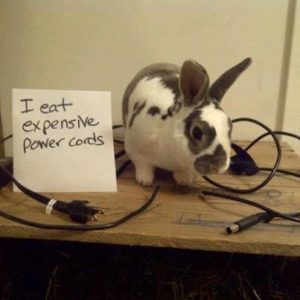
My rabbits usually do this when they want to get out of their cage or if I am eating something in front of them and they want a bite. Although adorable its best to make sure that your rabbits are not doing it excessively.
Destructive Digging
Even though digging is a playful behavior, some rabbits also dig when they are angry or being aggressive. This may cause damage to your furniture like your sofa or bed sheets.
Although it is often impossible to stop a rabbit from digging completely, you can reduce the damage they cause by clipping their nails or distract them with a treat.
Grunting
Rabbits grunt when you are doing something to them that they don’t like, this can usually be seen when you pet them when they are just not in the mood. Rabbit grunts are a warning for you to back off as they are most likely to bite you or lunge at you.
5. Dominance Rabbit Behavior
These behaviors are often seen if you have more then one rabbit, these behaviors can be social, sexual or territorial. Getting your rabbit spayed or neutered can help reduce dominance behaviors significantly.
Chasing
When more than one rabbit is housed together you will often see them chasing each other. Somethimes only the dominant rabbit will chase the others around.
Rabbis chase each other when they want to hump or when they want to follow the other rabbit out of curiosity. Rabbits will also chase other rabbits if they really want them to get out of their area.
Chasing is a behavior that rabbits display to establish dominance among each other, therefore it is also a clue for us humans to understand the complex social hierarchy that bunnies have within a group.
Chinning
Rabbits have scent glands under their chin which release pheromones. Although these pheromones are undetectable by us humans but it is an important marker for rabbits.
Rabbits use this pheromone released from their scent glands by rubbing the bottom of their chin on objects, their surroundings or humans. It is a way for rabbits to establish their territory and identify things in their surroundings.
Humping
Humping is the natural mating ritual for rabbits. Although humping may mean an urge to mate but it could mean a lot of different things in a rabbit group.
Rabbits will hump each other to assert dominance and this could occur quite frequently during the bonding process. Rabbits will hump each other regardless of their gender. I once mistook one of my female rabbits for a male rabbit just because she was humping another rabbit.
If your rabbits are spayed and neutered them humping is less likely to occur but it still may happen. There is nothing wrong if two rabbits are humping but you should keep an eye on them and separate them if they are getting violent.
Spraying
Spraying is another way for rabbits to mark their territory. You can sometimes see them spraying their pee on walls or maybe your furniture. This behavior is more prominent in male rabbits than females.
Although this behavior is very rare in rabbits who are spayed and neutered but it sometimes can occur due to some stimulus during a bonding process or if your bunny was fixed at an older age then recommended for spaying and neutering rabbits.
6. Sick Or In Pain
And lastly, these are the kind of behaviors that your rabbit may display when they are sick or in pain. Some of these may not mean that they are really sick. But since bunnies are so fragile it is best to take extra care and monitor your rabbit thoroughly. You may even consider reporting it to your rabbit friendly vet if your rabbit is showing any of these behaviors.
Pressed Stomach
Rabbits tend to press their stomachs against the ground when they are having a stomach ache. Although this might sound harmless but remember any stomach problem is a serious problem rabbit.
The number one killer of domestic rabbits is G.I Stasis, a medical condition where food gets stuck in rabbit’s guts and they lose their apitite, stop pooping and eventually die from not eating or pain.
And a rabbit with a pressed stomach may be showing symptoms of just that. That’s not to say that rabbits do not press their stomach against the ground otherwise. That is why it is critical that we must observe this behavior carefully and always stay in touch with a rabbit friendly vet throughout this period.
Tooth Grinding
When in pain rabbits sometimes grind their teeth when it becomes really unbearable. You may often see or hear your bunny grinding its teeth as well as be in a hunched position with their stomach pressed. While it may look like your bunny is just loafing but it may not be the case.
Again careful observation is required with prompt consultation with a rabbit friendly vet is paramount.
Head-Shaking
If your bunny is shaking its head and scratching its head continuously then it may indicate that your rabbit has an ear infection.
Ear infections are a very common problem for most domestic rabbits and can often be quite painful and troublesome disease for rabbits. If your bunny is shaking their head-scratching their ears then do not wait any further. Take them to the vet, although ear infections may not be life-threatening but your bunny will thank you for coming to its rescue.
Ending Thoughts
Rabbits are small yet intelligent creatures, they all have a different personality just like us humans. They may not be able to speak or show their emotions but their body language can help you understand what they really want to say.
So give it a go, observe your bunny and let us know how many of their behaviors you were able to identify and if this guide has helped you in any way then consider supporting this blog so we can keep making awesome content about Rabbits.
Catagories
- New To Rabbits (16)
- Rabbit Behavior (9)
- Rabbit Care (18)
- Rabbit Diet (12)
- Rabbit Facts (10)
